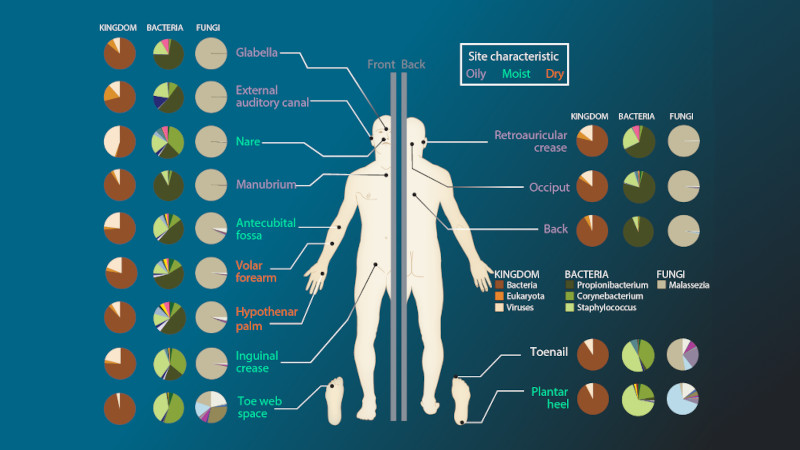Context
The best known property of ozonised oils is perhaps their disinfectant capacity1, 2, 3, 4. With the right technique and the necessary level of peroxidation, they have scientifically proven bactericidal, fungicidal and virucidal capacities.
Beyond the obvious question of the antiseptic capacity of ozonised oils, an interesting question arises: is the continued use of ozonised oils harmful to the microbiome? The answer, for daily users of the benefits of ozone hyperoxidised oils, is relatively simple: we do not suffer any alteration of our microbiome, on the contrary, it is strengthened.
Analysis
To support this theorem doctors from Third Xiangya Hospital and the University of South Carolina School of Medicine have conducted a study on 12 patients (4 men and 8 women from 6 to 28 years of age) with dermal involvement (Atopic Dermatitis).
Background: Staphylococcus aureus (S. aureus) accounts for 90% of the microbiome in lesions in atopic dermatitis (AD), and plays an important role in flares and worsens disease outcome.5,6
Methods: Patients with moderate to severe bilateral skin lesions in the AD were recruited for the study. They were randomly divided into two groups. One group was treated with ozone hydrotherapy followed by ozonised oil, while the other group was treated with tap water and basal oil. Before and after the treatments, the patients’ SCORAD scores (Scoring Atopic Dermatitis is the severity score for atopic dermatitis and a reference tool in the monitoring and evaluation of the pathology) and the modified EASI (Eczema Area and Severity Index is a tool to measure the severity of atopic dermatitis) were recorded. In addition, microbiological compositions in lesions were determined using 16S rRNA sequencing.
Results: After treatment with ozone therapy for three days, patients showed a significant decrease in SCORAD score and inflammatory cell infiltration in AD lesions.
Microbiological diversity was higher in uninjured areas compared to lesion areas, which also correlated negatively with AD severity.
The proportion of S. aureus in AD lesions correlated positively with AD severity, which decreased after ozone treatment.
Ozone therapy showed an increase in microbiological diversity with a significant increase in the proportion of Acinetobacter.
Study conclusion: Topical ozone therapy is very effective for the treatment of AD. It can change the proportional ratio of Staphylococcus and Acinetobacter, thus restoring microbiological diversity in AD lesions.
Conclusions
The antiseptic effect of ozonised oils causes the osmosis of bacteria to be broken, which prevents their proliferation. As the colonising bacteria depend on external contamination and a weakened flora, they do not present a problem for eradication. On the contrary, their own flora grows normally and rapidly, recovering the autochthonous microbiological niche and restoring the skin’s equilibrium.7
Juan Fernández
Biologist and CEO of KeyBiological
Member of the Spanish Society of Ozone Therapy – SEOT
Bibliographical references
- Montevecchi M, Dorigo A, Cricca M, Checchi L. Comparison of the antibacterial activity of an ozonated oil with chlorhexidine digluconate and povidone-iodine. A disk diffusion test. New Microbiol. 2013 Jul;36(3):289-302. Epub 2013 Jun 30. PMID: 23912871.
- Kinga Skalska, Stanisław Ledakowicz, Jan Perkowski & Barbara Sencio (2009) Germicidal Properties of Ozonated Sunflower Oil, Ozone: Science & Engineering, 31:3, 232-237, DOI: 10.1080/01919510902838669
- Ugazio E, Tullio V, Binello A, Tagliapietra S, Dosio F. Ozonated Oils as Antimicrobial Systems in Topical Applications. Their Characterization, Current Applications, and Advances in Improved Delivery Techniques. Molecules. 2020 Jan 14;25(2):334. doi: 10.3390/molecules25020334. PMID: 31947580; PMCID: PMC7024311.
- Silva V, Peirone C, Amaral JS, Capita R, Alonso-Calleja C, Marques-Magallanes JA, Martins Â, Carvalho Á, Maltez L, Pereira JE, Capelo JL, Igrejas G, Poeta P. High Efficacy of Ozonated Oils on the Removal of Biofilms Produced by Methicillin-Resistant Staphylococcus aureus (MRSA) from Infected Diabetic Foot Ulcers. Molecules. 2020 Aug 7;25(16):3601. doi: 10.3390/molecules25163601. PMID: 32784722; PMCID: PMC7464232.
- Hepburn, L., Hijnen, D., Sellman, B., Mustelin, T., Sleeman, M., May, R. and Strickland, I. (2017), The complex biology and contribution of Staphylococcus aureus in atopic dermatitis, current and future therapies. Br J Dermatol, 177: 63-71. https://doi.org/10.1111/bjd.15139
- Totté, J., van der Feltz, W., Hennekam, M., van Belkum, A., van Zuuren, E. and Pasmans, S. (2016), Prevalence and odds of Staphylococcus aureus carriage in atopic dermatitis: a systematic review and meta‐analysis. Br J Dermatol, 175: 687-695. https://doi.org/10.1111/bjd.14566
- Zeng J, Dou J, Gao L, Xiang Y, Huang J, Ding S, Chen J, Zeng Q, Luo Z, Tan W, Lu J. Topical ozone therapy restores microbiome diversity in atopic dermatitis. Int Immunopharmacol. 2020 Mar;80:106191. doi: 10.1016/j.intimp.2020.106191. Epub 2020 Jan 24. PMID: 31986325.

